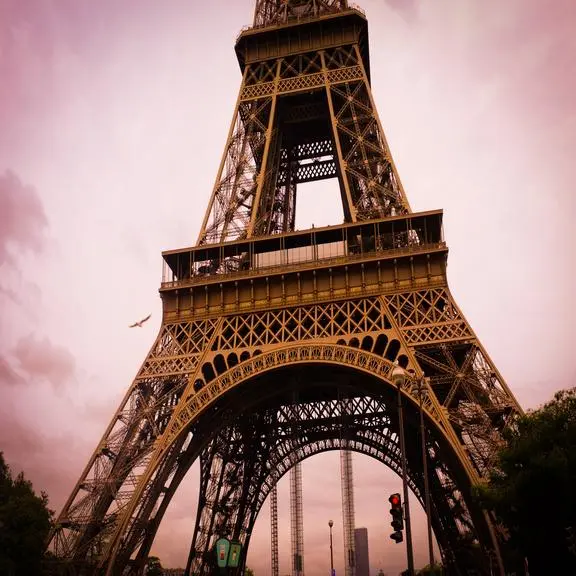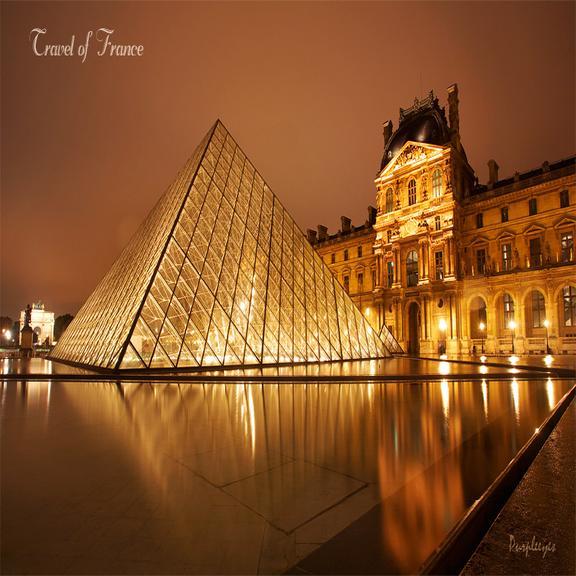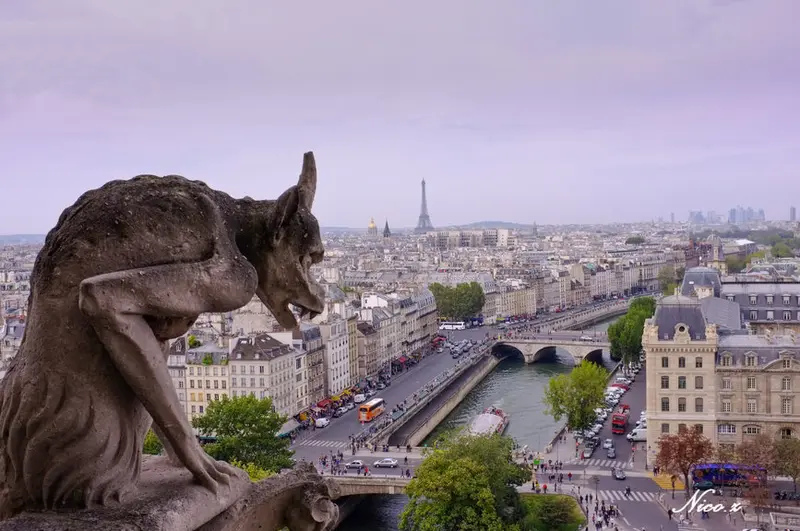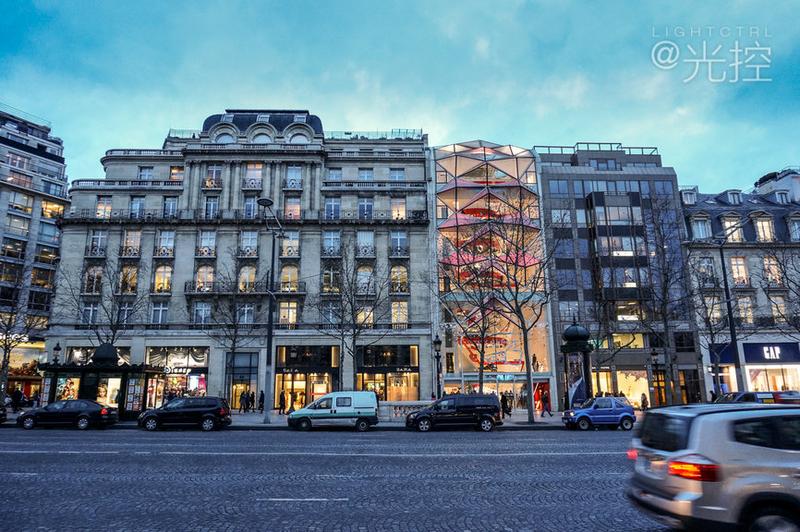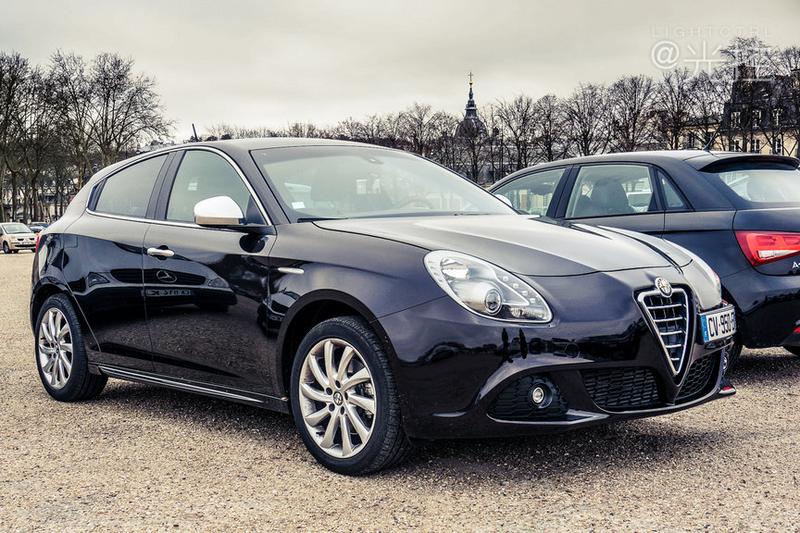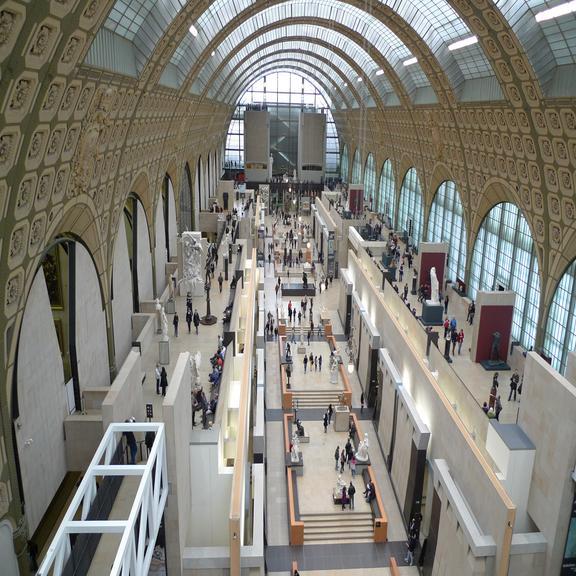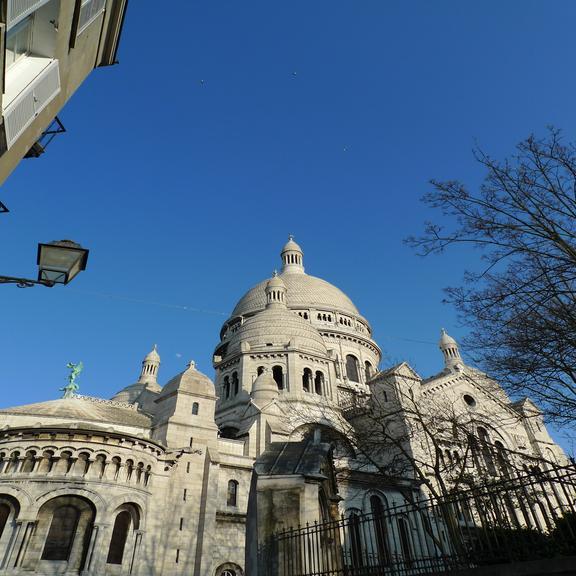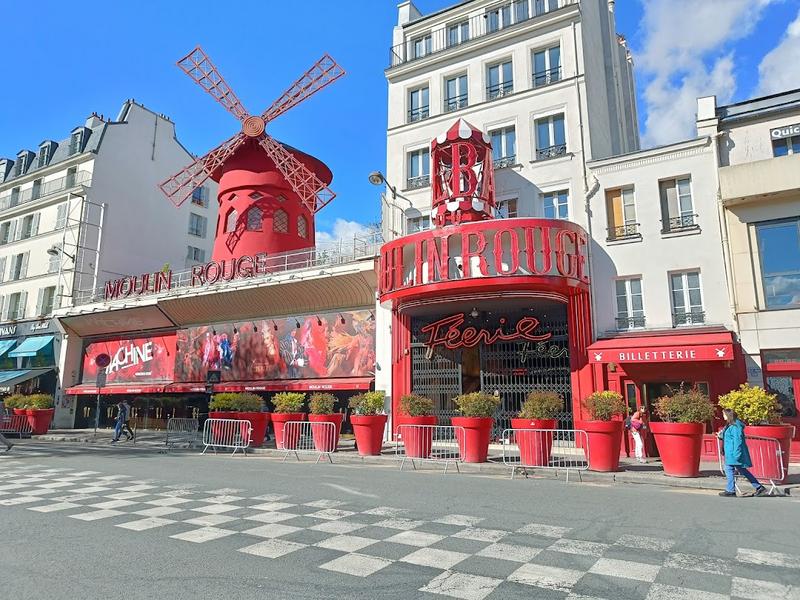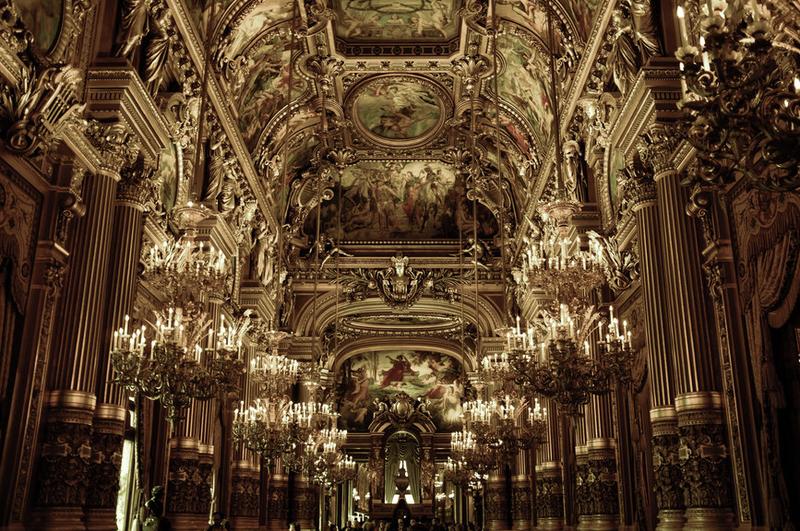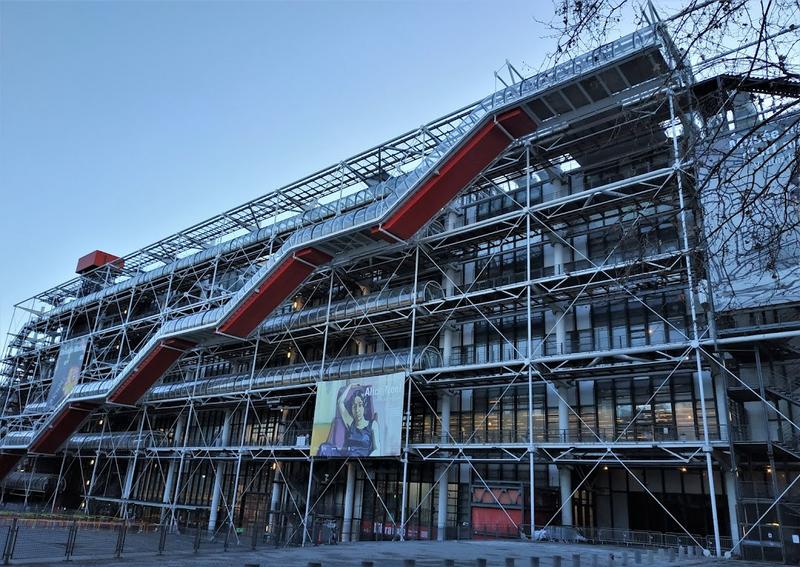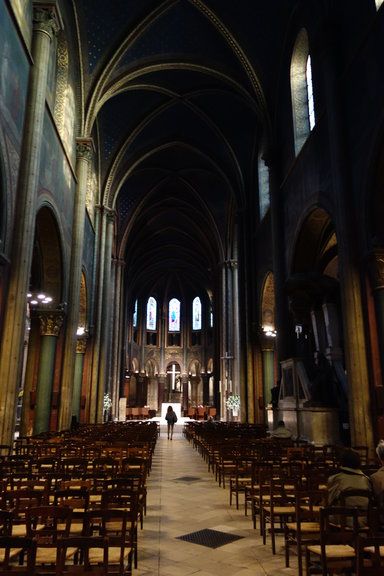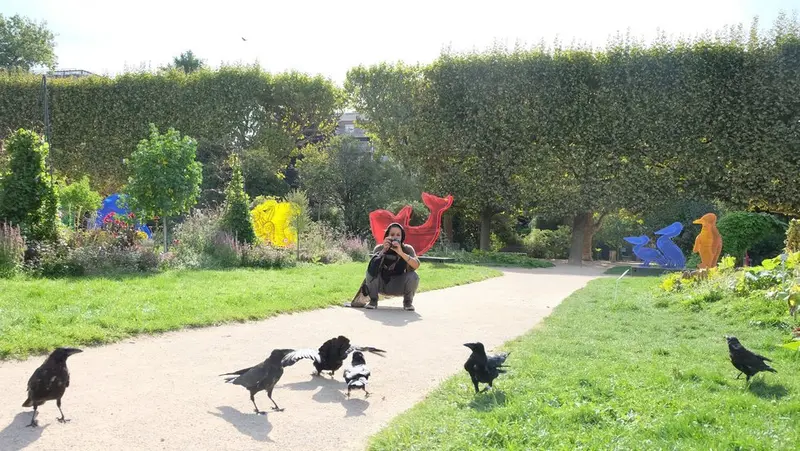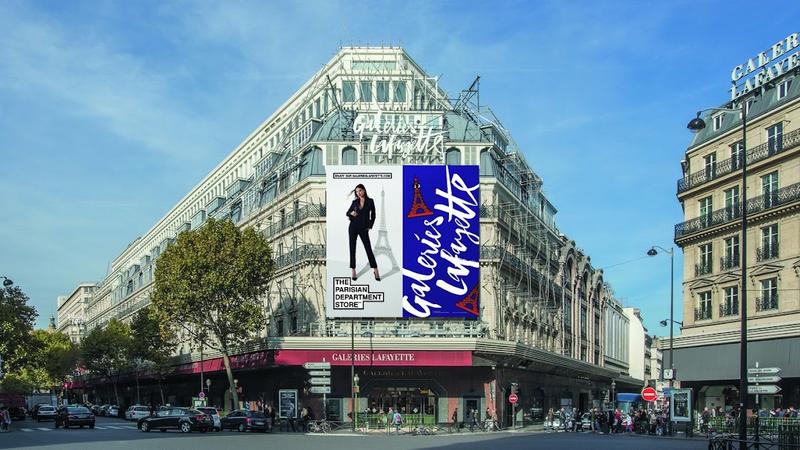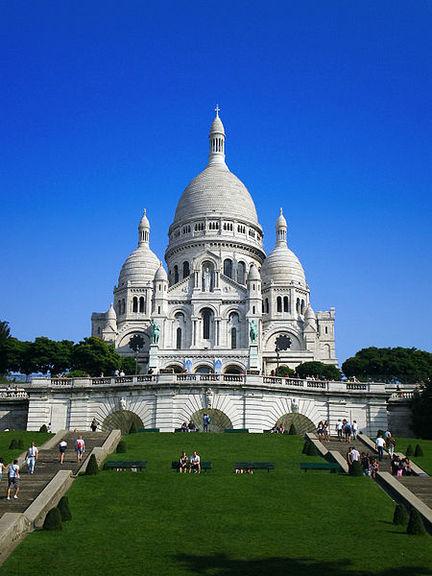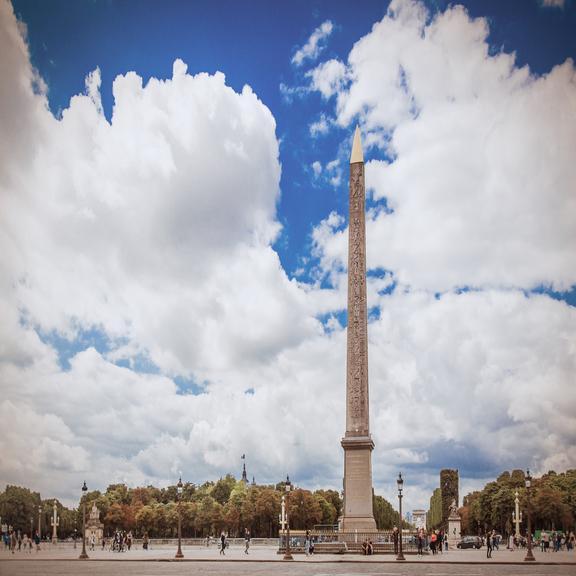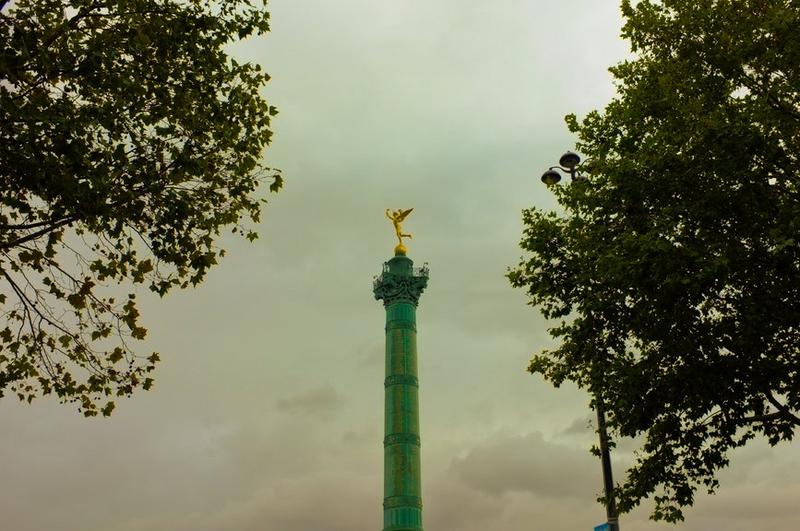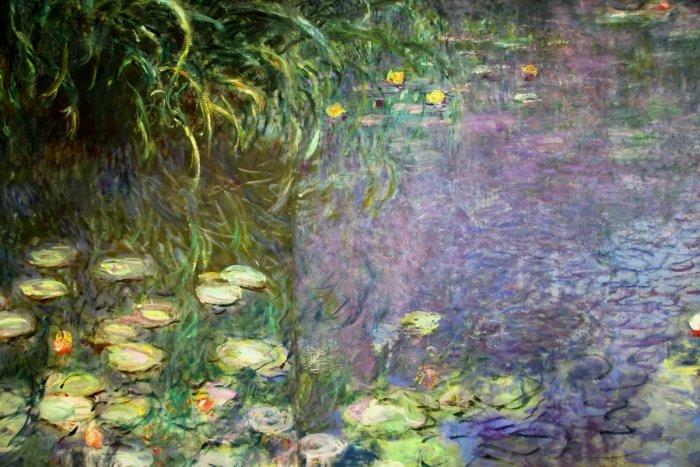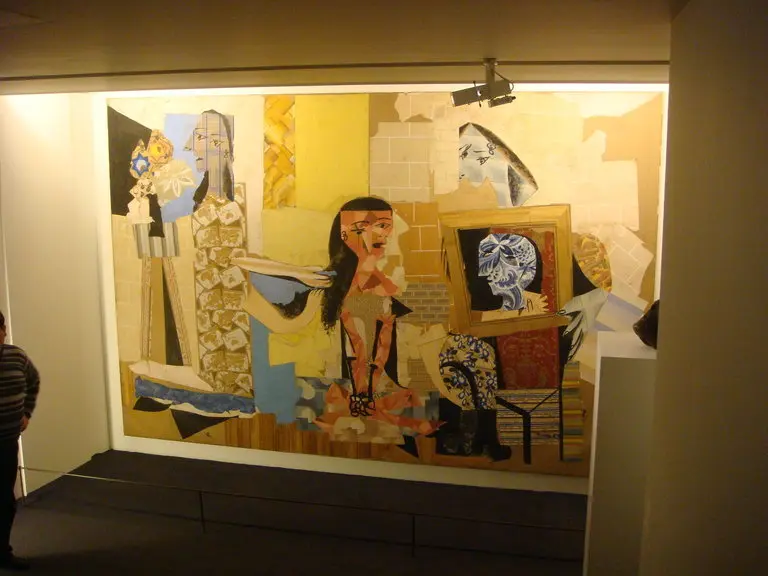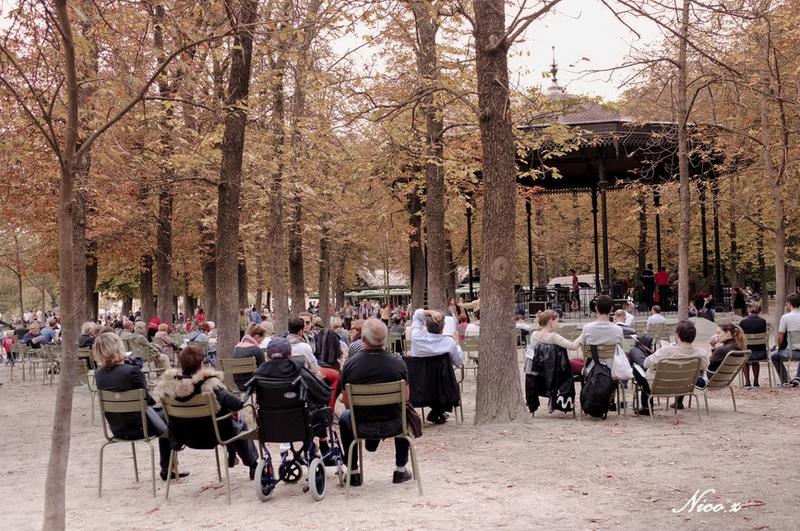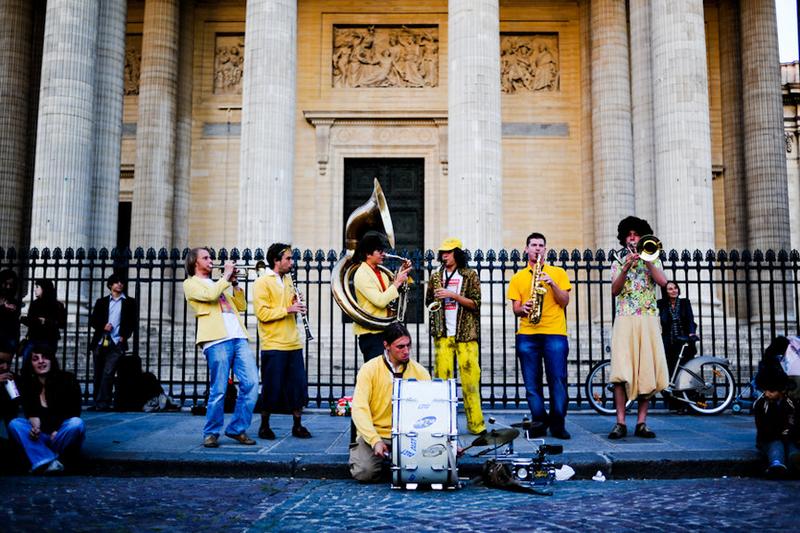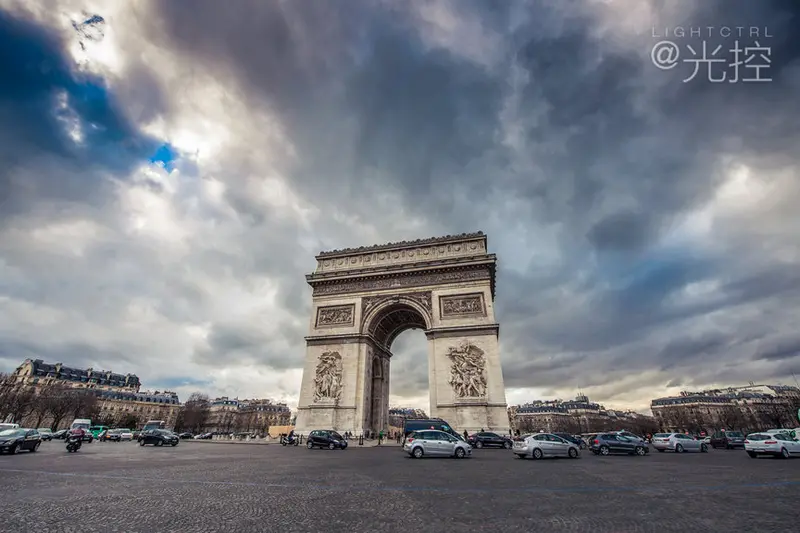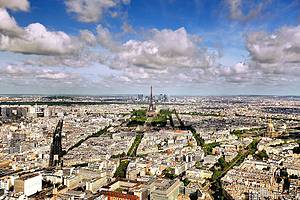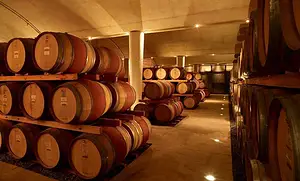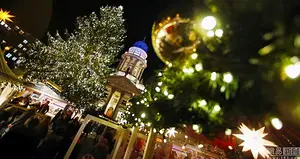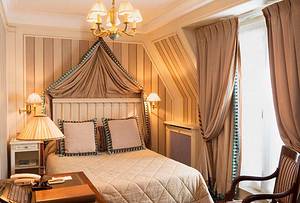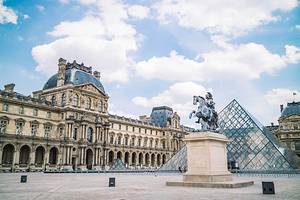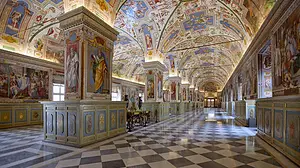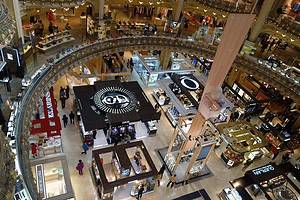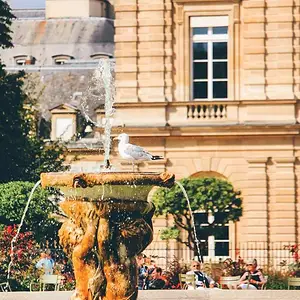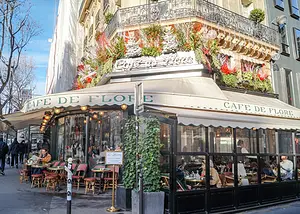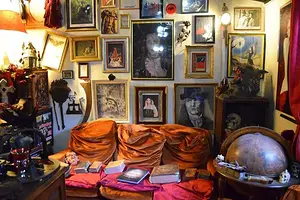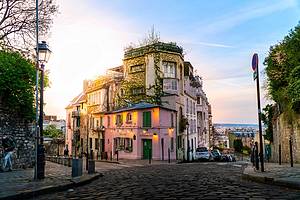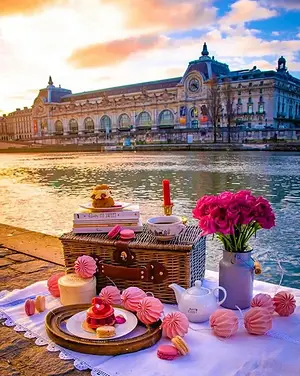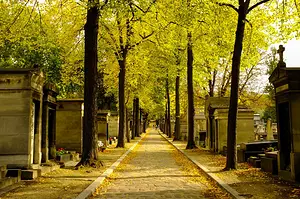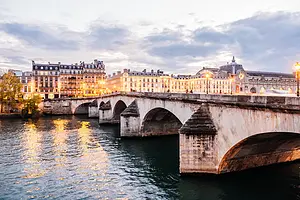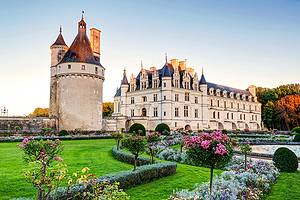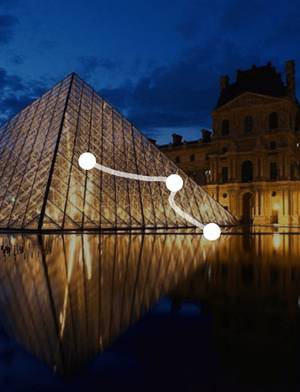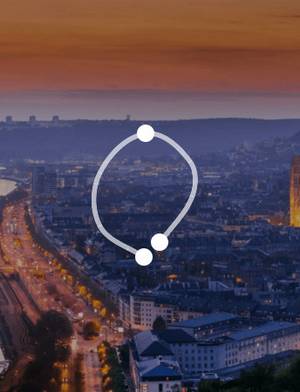Two Weeks in Paris
1 cities |
24 attraction(s) |
total distance 184
km
 TIPS
TIPS
Day1
Day2
Day3
Day4
Day5
Day6
Day7
Day8
Day9
Day10
Day11
Day12
Day13
Day14
Day15
Day16
Day17
Day18
Day19
Day1: Paris
4 attraction(s) ·
8 km
1
In 1889, the Eiffel Tower was built to commemorate the 100th anniversary of the French Revolution and to welcome the World Expo. This 324-meter-tall giant steel structure was initially controversial as it clashed with the architecture of Paris, and some even called for its demolition. However, today the Eiffel Tower has become a symbol of France and Paris.
Visitors can take the elevator or climb the stairs to reach the top of the tower and enjoy the breathtaking view of the city. On New Year's Eve, the tower sparkles for ten minutes at the top of each hour, and on specific holidays, it displays different colors, such as red for the Chinese New Year and blue for EU Day. During National Day, the Champ de Mars below the tower is an ideal venue for music festivals and New Year celebrations.
There are also two restaurants on the tower: Tour Eiffel 58 and the Michelin-starred restaurant Jules Verne. Tour Eiffel 58 offers lunch and dinner, starting at €19 for lunch and €80 for dinner, but with a higher cover charge. Jules Verne used to be a three-star Michelin restaurant but now has only one star. Lunch starts at €90, and dinner costs around €300 per person. Despite the expensive prices, they are still highly sought after due to their unique location. Therefore, it is advisable to book at least two months in advance during the peak season. If your budget allows, it is recommended to try other three-star Michelin restaurants for a better gastronomic experience.
4
km
2
The Louvre Museum is the former residence of French kings, built in the late 12th century. After several expansions and renovations during different periods of reign, it has become one of the largest museums in the world. The Louvre is divided into eight sections, including Oriental Antiquities, Egypt, Greece, Etruria and Ancient Rome, Paintings, Sculptures, Art Objects, Islamic Art, and Medieval to 1848 Paintings.
Originally a medieval fortress defending Paris, the Louvre has played various roles throughout history. With a love for art, French kings sponsored artists and collected a large number of renowned Italian paintings. During the French Revolution, it was opened as a museum and continued to expand and collect more artistic treasures in subsequent historical periods. The Louvre houses around 400,000 artifacts, with approximately 40,000 on regular display. Visitors should prepare in advance and, based on personal interests, it is recommended to visit the Italian and French painting galleries, Ancient Egypt Civilization gallery, Ancient Greek and Roman art gallery, and Napoleon III's apartments. As one of the world's top three museums, the Louvre attracts numerous visitors and has become one of the most popular tourist destinations in the world.
2
km
3
Notre-Dame Cathedral is located on the Île de la Cité in the center of Paris, France. It is a Gothic-style church and the cathedral of the Catholic Archdiocese of Paris. Built between 1163 and 1250, the cathedral has a history of 850 years, witnessing the changes in Paris's history, as well as Napoleon's coronation and the wedding of Napoleon III. The famous novel "The Hunchback of Notre-Dame" by Victor Hugo has also made the cathedral a popular tourist destination. Many people climb to the bell tower to search for the Hunchback, but long queues are common during peak season. In addition, on the first Friday of each month at 3 pm, you can see the exhibition of three relics. Visiting Notre-Dame Cathedral is free, but please respect local religious customs and dress codes, and maintain silence. If you want to visit the bell tower, you can buy tickets on the left side of the church, but be prepared for wait times of over two hours during peak season.
4
km
4
The famous Champs-Élysées is located in the 8th arrondissement of Paris and is known as the most beautiful street in the city. Its name is inspired by the Elysium in Greek mythology, the dwelling place of saints and heroes, symbolizing romance and freedom.
The Champs-Élysées is the central axis of Paris, with the Arc de Triomphe at its western end and the Concorde Square at its eastern end. It is also connected to the Louvre through the Arc de Triomphe du Carrousel. The street is decorated with special lights during major holidays, and important events like the Bastille Day parade and the final stage of the Tour de France are held here.
Nowadays, the Champs-Élysées is often crowded, but there are only a few luxury brands such as Cartier and Mont Blanc on the avenue. The true luxury shopping district is formed by the adjacent Avenue Montaigne, Avenue George V, and Rue François I, known as the Golden Triangle, attracting numerous shoppers. However, during Christmas and New Year, the street becomes particularly lively with the dreamy lights on the trees and the Christmas market, creating a joyful atmosphere for visitors. The street is also vibrant in July, with tropical carnival before the Bastille Day and the final stage of the Tour de France after the national holiday. Sometimes, the French even turn the entire Champs-Élysées into vegetable gardens to educate the public about the sources of food on their tables.
Day2: Paris
4 attraction(s) ·
21 km
1
This article introduces the history and highlights of the Palace of Versailles in France. The palace was built by King Louis XIV, also known as the Sun King, using 30,000 workers in order to rival the Château de Vaux-le-Vicomte, the castle of his jealous finance minister, Fouquet. After the French Revolution, the Palace of Versailles became a French history museum and witnessed many historical events, such as the signing of the Treaty of Paris by England and America, the signing of the Treaty of Versailles by France, England, America, and Germany, and the declaration of the end of World War I. The Hall of Mirrors and the Gallery of Battles are the most famous highlights of the Palace of Versailles, along with many exquisite rooms and gardens. Emperor Kangxi of China and King Louis XIV were contemporaneous monarchs who promoted cultural exchanges between France and China in the 17th century, so there are portraits of Emperor Kangxi and Chinese porcelain in the Palace of Versailles. King Louis XIV personally appointed Zhang Cheng, Bai Jin, and others to China to survey and map the country, and Emperor Kangxi also learned about Western natural science knowledge. Bai Jin was sent back to France by Emperor Kangxi to recruit scientists and brought with him a large number of Chinese porcelain and other gifts given by Louis XIV. Emperor Kangxi, together with Chinese scholars, drew a national map based on provincial divisions, leaving a mark of Chinese history in the Palace of Versailles.
17
km
2
The Jardin des Tuileries in front of the Louvre is a beautiful public garden located on the opposite bank of the River Seine. It used to be a train station in the past, but now the charming building with a large clock has been transformed into one of the museums with the largest collection of Impressionist artworks in the world. As one of the three major museums in Paris, the Musée d'Orsay mainly houses art treasures from 1848 to 1912. If you are interested in the works of Impressionist masters, this is definitely a must-visit place for you. Here, you can admire many important works, such as Vincent van Gogh's "Self-Portrait" and "The Church in Auvers," Claude Monet's "Impression, Sunrise" and "Woman with a Parasol," Jean-François Millet's "The Gleaners," Edouard Manet's "Le Dejeuner sur l'herbe," Paul Cézanne's "Still Life," as well as numerous masterpieces by Renoir, Gauguin, Picasso, and more. If you are interested in works prior to 1848, you can visit the Louvre, and if you enjoy artworks from after 1912, it is recommended to visit the Pompidou Center.
4
km
3
Montmartre is a small village located on a hill about 130 meters high outside the northern city of Paris. It is the geographical high point of Paris and was once a gathering place for impoverished artists. It quickly became the center of drinking and entertainment in Paris due to its location outside the city and its production of wine, giving rise to landmarks such as the Moulin Rouge and the Black Cat. Montmartre attracted many impoverished artists such as Van Gogh, Picasso, Matisse, and Renoir. Today, Montmartre has developed into an upscale residential area with numerous hotels and restaurants. It is also a popular tourist destination due to its portrayal in films like "Amélie". There are various tourist attractions, such as the Basilica of the Sacred Heart and the Place du Tertre. The steps in front of the Basilica offer the best vantage point to admire the entire city of Paris, and there are also cafes and restaurants here. The Place du Tertre is crowded with painters, and you can have your portrait painted by your favorite artist. Couples can also seek out the "I Love You" wall that features the phrase in various languages. Other notable attractions include the Pancake Windmill, the Place du Pigalle, the Cunning Rabbit Bar, the Montmartre Museum, the Montmartre Cemetery, and the Passe-Muraille. In addition, Montmartre exudes a strong artistic atmosphere, with street performers and painters visible everywhere. You can experience the nightlife by visiting the Moulin Rouge and other bars. Whether during the day or at night, Montmartre is worth a visit and is a charming scenic area.
1
km
4
Famed 19th-century cabaret featuring Belle Epoque decor, dinner & dancers in elaborate costumes.
Day3: Paris
3 attraction(s) ·
4 km
1
The Garnier Opera House is located at the intersection of Paris and was redesigned by Napoleon III and Haussmann, and eventually adopted the design proposal of the young architect Garnier. When Queen Eugenie saw this design, she was surprised to find that it did not resemble Romanesque, Classical, Louis XIV, or Louis XV styles. It turned out to be designed by her husband! The opera house symbolizes the love between Napoleon III and Eugenie, and the letters N and E at the top represent this. The opera house used to be a popular place for upper-class society to date. Wealthy young people would meet at the statue of the nude goddess in front of the opera house and then go to nearby rue de la Paix and Place Vendôme to buy engagement rings. This custom has evolved into the tradition of "giving diamond engagement rings". Nowadays, most performances have been relocated to the Bastille Opera House. The Garnier Opera House is open to visitors during the day and offers ballet and opera performances. Next to the opera house is Rue de la Banque, where there are now many restaurants with good quality and low prices. Behind it are the Galeries Lafayette and Printemps, making it the busiest place in Paris.
2
km
2
Architecturally avant-garde complex housing National Museum of Modern Art, library and music center.
2
km
3
This church is one of the oldest buildings in the history of Paris. The bell tower was once referred to as the "spice rack on the dining table" by the famous writer Hugo, and it is also the eternal resting place of the philosophical giant Descartes.
Day4: Paris
4 attraction(s) ·
15 km
1
The Paris Botanical Garden is located on the left bank of the Seine River in Paris, France. It is close to the National Museum of Natural History and is recognized as one of the world's famous botanical gardens. Its affiliated zoo also holds an important position in the history of zoos worldwide.
5
km
2
Zoo with naturalistic habitats including savannah for giraffes & zebras & Patagonia for manchot.
7
km
3
The Catacombs of Paris, also known as the Skull Cemetery, is located in the Place Denfert-Rochereau in the 14th arrondissement of Paris. Originally a limestone quarry, it became a famous burial ossuary after a plague outbreak in 1786. Citizens moved the bones from all the city's cemeteries here to address public health and burial space issues. The cemetery was used for almost 30 years and was converted into a museum in 1814. Today, only a part of the ossuary is open to visitors. It is said to contain over 6 million sets of bones, with a total length of nearly 300 kilometers. The site can accommodate a maximum of 200 visitors per day. When exploring this world of skulls, pay attention to the inscriptions on the tombstones and delve into the historical background of this ancient burial ossuary.
5
km
4
Grand, century-old department store with a steel-frame art nouveau glass dome ringed by loggias.
Day5: Paris
4 attraction(s) ·
10 km
1
The Sacré-Cœur Basilica, located on the Montmartre hill in Paris, is one of the most iconic Catholic churches in France. It was completed in 1914 but did not officially open until 1919 due to the outbreak of World War I.
The architectural style of the Sacré-Cœur is a blend of Roman and Byzantine influences, with many nationalistic elements. The church features three archways and statues of Saint Joan of Arc and King Louis IX on horseback. The 19-ton Savoyarde bell, cast in 1885, is one of the largest bells in the world. The construction of the Sacré-Cœur was funded entirely by private donations, amounting to approximately 7 million francs, which were exhausted before ground construction even began. A temporary altar was established on March 3, 1876, and it quickly became the main source of funds through pilgrim donations.
The Sacré-Cœur was built using limestone extracted by Châtillon quarries, which continuously releases calcite and ensures that the basilica maintains its white appearance despite weathering and pollution. The church's dome houses one of the largest mosaics in the world, known as the Christ in Majesty. Surrounding the Sacré-Cœur is a garden where people can reflect and meditate, featuring ornamental fountains.
The platform in front of the church provides a partial view of the city center of Paris, and visitors can also climb 300 steps to the top of the bell tower for an unobstructed panoramic view of the city.
5
km
2
Hôtel des Invalides, also known as the National Residence of the Invalids, is a popular military museum located in the 7th arrondissement of Paris, France. The building was originally constructed in 1670 as a hospital for the French army by King Louis XIV. In 1861, Napoleon Bonaparte's tomb was moved to the chapel of the Hôtel des Invalides. The museum attracts a large number of visitors daily, with Napoleon's sarcophagus located on the ground floor and can be viewed from the upper-level circular corridor. The golden-domed chapel of the Hôtel des Invalides houses the red coffin of Napoleon, drawing crowds of people who come to pay their respects. The military museum within the Hôtel des Invalides showcases war weapons from different historical periods and countries, as well as a World War II memorial, evoking memories of that era.
2
km
3
Concorde Square in the center of Paris, France, is a large square with an area of approximately 84,000 square meters. It is home to a huge Egyptian obelisk. The obelisk was originally located at the entrance of the Luxor Temple, praising the rule of Pharaoh Ramesses II. In 1829, the Ottoman Empire's Egyptian viceroy, Muhammad Ali, presented it to France. The obelisk arrived in Paris on December 21, 1833, and was erected in the center of Concorde Square by French King Louis-Philippe on October 25, 1836. In 1998, the French government added a golden pyramidion to replace the original missing top.
4
km
4
Bastille Square, located in Paris, was the site of the Bastille prison and was completely destroyed during the French Revolution. Today, it has disappeared without a trace. Bastille Square frequently hosts concerts and other events, becoming an essential part of the city's cultural life. The northeast of Bastille is filled with cafes, bars, nightclubs, and music halls, truly becoming a popular gathering place for nightlife.
Day6: Paris
4 attraction(s) ·
5 km
1
The Louvre Museum is the former residence of French kings, built in the late 12th century. After several expansions and renovations during different periods of reign, it has become one of the largest museums in the world. The Louvre is divided into eight sections, including Oriental Antiquities, Egypt, Greece, Etruria and Ancient Rome, Paintings, Sculptures, Art Objects, Islamic Art, and Medieval to 1848 Paintings.
Originally a medieval fortress defending Paris, the Louvre has played various roles throughout history. With a love for art, French kings sponsored artists and collected a large number of renowned Italian paintings. During the French Revolution, it was opened as a museum and continued to expand and collect more artistic treasures in subsequent historical periods. The Louvre houses around 400,000 artifacts, with approximately 40,000 on regular display. Visitors should prepare in advance and, based on personal interests, it is recommended to visit the Italian and French painting galleries, Ancient Egypt Civilization gallery, Ancient Greek and Roman art gallery, and Napoleon III's apartments. As one of the world's top three museums, the Louvre attracts numerous visitors and has become one of the most popular tourist destinations in the world.
1
km
2
The Jardin des Tuileries in front of the Louvre is a beautiful public garden located on the opposite bank of the River Seine. It used to be a train station in the past, but now the charming building with a large clock has been transformed into one of the museums with the largest collection of Impressionist artworks in the world. As one of the three major museums in Paris, the Musée d'Orsay mainly houses art treasures from 1848 to 1912. If you are interested in the works of Impressionist masters, this is definitely a must-visit place for you. Here, you can admire many important works, such as Vincent van Gogh's "Self-Portrait" and "The Church in Auvers," Claude Monet's "Impression, Sunrise" and "Woman with a Parasol," Jean-François Millet's "The Gleaners," Edouard Manet's "Le Dejeuner sur l'herbe," Paul Cézanne's "Still Life," as well as numerous masterpieces by Renoir, Gauguin, Picasso, and more. If you are interested in works prior to 1848, you can visit the Louvre, and if you enjoy artworks from after 1912, it is recommended to visit the Pompidou Center.
1
km
3
The Orange Garden Art Museum is located by the Seine River in the Tuileries Garden, and was built in 1852 for the cultivation of orange trees in the garden. After multiple renovations, the museum now showcases masterpieces such as Monet's "Water Lilies" and works by Picasso, Cézanne, Renoir, and other famous artists in two exhibition halls. Although the scale of the exhibition is small, the level of excellence is no less than that of other large museums. Sitting on the bench in the center of the exhibition hall, you can quietly feel the subtle changes of Monet's garden in different seasons. In addition, the museum periodically holds temporary exhibitions, allowing you to have a more comprehensive appreciation of various artistic beauty.
3
km
4
The museum reopened in October this year, after being closed in September 2011. It houses works from different periods of Picasso's artistic career, including pieces acquired by the French government in 1973, the year of Picasso's death, as well as a large collection of works acquired after his widow's death in 1990. The collection consists of a total of 251 paintings, 160 sculptures, 107 ceramic pieces, and 1,500 sketches.
Day7: Paris
4 attraction(s) ·
6 km
1
Montmartre is a small village located on a hill about 130 meters high outside the northern city of Paris. It is the geographical high point of Paris and was once a gathering place for impoverished artists. It quickly became the center of drinking and entertainment in Paris due to its location outside the city and its production of wine, giving rise to landmarks such as the Moulin Rouge and the Black Cat. Montmartre attracted many impoverished artists such as Van Gogh, Picasso, Matisse, and Renoir. Today, Montmartre has developed into an upscale residential area with numerous hotels and restaurants. It is also a popular tourist destination due to its portrayal in films like "Amélie". There are various tourist attractions, such as the Basilica of the Sacred Heart and the Place du Tertre. The steps in front of the Basilica offer the best vantage point to admire the entire city of Paris, and there are also cafes and restaurants here. The Place du Tertre is crowded with painters, and you can have your portrait painted by your favorite artist. Couples can also seek out the "I Love You" wall that features the phrase in various languages. Other notable attractions include the Pancake Windmill, the Place du Pigalle, the Cunning Rabbit Bar, the Montmartre Museum, the Montmartre Cemetery, and the Passe-Muraille. In addition, Montmartre exudes a strong artistic atmosphere, with street performers and painters visible everywhere. You can experience the nightlife by visiting the Moulin Rouge and other bars. Whether during the day or at night, Montmartre is worth a visit and is a charming scenic area.
4
km
2
This church is one of the oldest buildings in the history of Paris. The bell tower was once referred to as the "spice rack on the dining table" by the famous writer Hugo, and it is also the eternal resting place of the philosophical giant Descartes.
1
km
3
Luxembourg Park is the central park of the Latin Quarter in Paris, built during the reign of Louis XIII. Covering an area of 224,500 square meters, it has become a favorite place for students and tourists in Paris. The park is home to the Luxembourg Palace and the Luxembourg Museum, the former being the seat of the French Senate, and the latter regularly hosting short-term exhibitions. The park is also dotted with many statues and artworks, showcasing characters and animals from Greek mythology, as well as artists like Beethoven and Baudelaire. In the center of the park, on the flat ground, stands a statue of many French queens and one of the prototypes of the Statue of Liberty.
1
km
4
The ancestral temple was initially built in the 18th century by King Louis XV of France as part of the Sainte-Geneviève Church. After several renovations, it became a famous burial place for cultural celebrities. This building is an early representative of Neoclassical architecture, with a façade modeled after the Pantheon in Rome and a dome in the Brahmantic style. After a major illness in 1744, King Louis XV decided to build a temple for his protector, Jéna-Viève, and the Marquis of Margeny was responsible for the construction, with the designer Jacques-Germain Soufflot in charge of the specific design. The church was designed as a Latin Cross with a porch supported by Corinthian columns. The main building is 110 meters long, 84 meters wide, and 83 meters high, with a basement of roughly the same size. The completion of the church coincided with the beginning of the French Revolution, and the revolutionary regime converted the church into a mausoleum for burying "great French people." Before the building was finally used as an ancestral temple, it had been converted back to a church twice. In 1851, Léon Foucault displayed his famous Foucault pendulum here, and the iron ring from the French National School of Arts and Crafts was moved here. In 1791, the church was converted into a national ancestral temple, but it was twice restored to a religious altar in the 19th century. It wasn't until Hugo's funeral in 1885 that this building officially became a non-religious civic hall.
Day8: Paris
4 attraction(s) ·
5 km
1
In 1889, the Eiffel Tower was built to commemorate the 100th anniversary of the French Revolution and to welcome the World Expo. This 324-meter-tall giant steel structure was initially controversial as it clashed with the architecture of Paris, and some even called for its demolition. However, today the Eiffel Tower has become a symbol of France and Paris.
Visitors can take the elevator or climb the stairs to reach the top of the tower and enjoy the breathtaking view of the city. On New Year's Eve, the tower sparkles for ten minutes at the top of each hour, and on specific holidays, it displays different colors, such as red for the Chinese New Year and blue for EU Day. During National Day, the Champ de Mars below the tower is an ideal venue for music festivals and New Year celebrations.
There are also two restaurants on the tower: Tour Eiffel 58 and the Michelin-starred restaurant Jules Verne. Tour Eiffel 58 offers lunch and dinner, starting at €19 for lunch and €80 for dinner, but with a higher cover charge. Jules Verne used to be a three-star Michelin restaurant but now has only one star. Lunch starts at €90, and dinner costs around €300 per person. Despite the expensive prices, they are still highly sought after due to their unique location. Therefore, it is advisable to book at least two months in advance during the peak season. If your budget allows, it is recommended to try other three-star Michelin restaurants for a better gastronomic experience.
2
km
2
The famous Champs-Élysées is located in the 8th arrondissement of Paris and is known as the most beautiful street in the city. Its name is inspired by the Elysium in Greek mythology, the dwelling place of saints and heroes, symbolizing romance and freedom.
The Champs-Élysées is the central axis of Paris, with the Arc de Triomphe at its western end and the Concorde Square at its eastern end. It is also connected to the Louvre through the Arc de Triomphe du Carrousel. The street is decorated with special lights during major holidays, and important events like the Bastille Day parade and the final stage of the Tour de France are held here.
Nowadays, the Champs-Élysées is often crowded, but there are only a few luxury brands such as Cartier and Mont Blanc on the avenue. The true luxury shopping district is formed by the adjacent Avenue Montaigne, Avenue George V, and Rue François I, known as the Golden Triangle, attracting numerous shoppers. However, during Christmas and New Year, the street becomes particularly lively with the dreamy lights on the trees and the Christmas market, creating a joyful atmosphere for visitors. The street is also vibrant in July, with tropical carnival before the Bastille Day and the final stage of the Tour de France after the national holiday. Sometimes, the French even turn the entire Champs-Élysées into vegetable gardens to educate the public about the sources of food on their tables.
2
km
3
The Arc de Triomphe is located in the center of Place Charles de Gaulle in Paris and is also known as the "Triumphal Arch." The construction of the monument began in 1806 to celebrate a great victory in the Battle of Austerlitz, with Napoleon laying the first stone. Unfortunately, Napoleon did not live to see its completion. Twenty years later, a funeral was held under the Arc de Triomphe to honor him.
Walking from the underground tunnel of the Champs-Élysées to beneath the Arc de Triomphe, visitors can see an unknown soldier's tomb and an eternal flame, which is lit to honor the 1.5 million French soldiers who sacrificed their lives in World War I. On important holidays, a giant French flag is hung at the top of the Arc de Triomphe, accompanied by related commemorative activities. For example, May 8th commemorates Victory in Europe Day from World War II, and November 11th commemorates Armistice Day from World War I.
On July 14th, the national holiday military parade takes place from the Arc de Triomphe to Place de la Concorde. To secure a good spot, visitors need to wake up early and queue in advance. On certain clear mornings, visitors may find some people already waiting quietly beneath the Arc de Triomphe. Additionally, the monument becomes the center of New Year's Eve celebrations, attracting a large crowd, although there are no fireworks in Paris.
The Arc de Triomphe serves as the hub, with twelve major avenues radiating from it. Among them, the most famous one is the Avenue des Champs-Élysées, leading straight from the Louvre to Place de la Concorde. This nearly two-kilometer-long avenue is considered one of the most beautiful streets in the world.
3
km
4
Concorde Square in the center of Paris, France, is a large square with an area of approximately 84,000 square meters. It is home to a huge Egyptian obelisk. The obelisk was originally located at the entrance of the Luxor Temple, praising the rule of Pharaoh Ramesses II. In 1829, the Ottoman Empire's Egyptian viceroy, Muhammad Ali, presented it to France. The obelisk arrived in Paris on December 21, 1833, and was erected in the center of Concorde Square by French King Louis-Philippe on October 25, 1836. In 1998, the French government added a golden pyramidion to replace the original missing top.
Day9: Paris
4 attraction(s) ·
5 km
1
The Louvre Museum is the former residence of French kings, built in the late 12th century. After several expansions and renovations during different periods of reign, it has become one of the largest museums in the world. The Louvre is divided into eight sections, including Oriental Antiquities, Egypt, Greece, Etruria and Ancient Rome, Paintings, Sculptures, Art Objects, Islamic Art, and Medieval to 1848 Paintings.
Originally a medieval fortress defending Paris, the Louvre has played various roles throughout history. With a love for art, French kings sponsored artists and collected a large number of renowned Italian paintings. During the French Revolution, it was opened as a museum and continued to expand and collect more artistic treasures in subsequent historical periods. The Louvre houses around 400,000 artifacts, with approximately 40,000 on regular display. Visitors should prepare in advance and, based on personal interests, it is recommended to visit the Italian and French painting galleries, Ancient Egypt Civilization gallery, Ancient Greek and Roman art gallery, and Napoleon III's apartments. As one of the world's top three museums, the Louvre attracts numerous visitors and has become one of the most popular tourist destinations in the world.
1
km
2
The Jardin des Tuileries in front of the Louvre is a beautiful public garden located on the opposite bank of the River Seine. It used to be a train station in the past, but now the charming building with a large clock has been transformed into one of the museums with the largest collection of Impressionist artworks in the world. As one of the three major museums in Paris, the Musée d'Orsay mainly houses art treasures from 1848 to 1912. If you are interested in the works of Impressionist masters, this is definitely a must-visit place for you. Here, you can admire many important works, such as Vincent van Gogh's "Self-Portrait" and "The Church in Auvers," Claude Monet's "Impression, Sunrise" and "Woman with a Parasol," Jean-François Millet's "The Gleaners," Edouard Manet's "Le Dejeuner sur l'herbe," Paul Cézanne's "Still Life," as well as numerous masterpieces by Renoir, Gauguin, Picasso, and more. If you are interested in works prior to 1848, you can visit the Louvre, and if you enjoy artworks from after 1912, it is recommended to visit the Pompidou Center.
1
km
3
The Orange Garden Art Museum is located by the Seine River in the Tuileries Garden, and was built in 1852 for the cultivation of orange trees in the garden. After multiple renovations, the museum now showcases masterpieces such as Monet's "Water Lilies" and works by Picasso, Cézanne, Renoir, and other famous artists in two exhibition halls. Although the scale of the exhibition is small, the level of excellence is no less than that of other large museums. Sitting on the bench in the center of the exhibition hall, you can quietly feel the subtle changes of Monet's garden in different seasons. In addition, the museum periodically holds temporary exhibitions, allowing you to have a more comprehensive appreciation of various artistic beauty.
3
km
4
The museum reopened in October this year, after being closed in September 2011. It houses works from different periods of Picasso's artistic career, including pieces acquired by the French government in 1973, the year of Picasso's death, as well as a large collection of works acquired after his widow's death in 1990. The collection consists of a total of 251 paintings, 160 sculptures, 107 ceramic pieces, and 1,500 sketches.
Day10: Paris
4 attraction(s) ·
6 km
1
Montmartre is a small village located on a hill about 130 meters high outside the northern city of Paris. It is the geographical high point of Paris and was once a gathering place for impoverished artists. It quickly became the center of drinking and entertainment in Paris due to its location outside the city and its production of wine, giving rise to landmarks such as the Moulin Rouge and the Black Cat. Montmartre attracted many impoverished artists such as Van Gogh, Picasso, Matisse, and Renoir. Today, Montmartre has developed into an upscale residential area with numerous hotels and restaurants. It is also a popular tourist destination due to its portrayal in films like "Amélie". There are various tourist attractions, such as the Basilica of the Sacred Heart and the Place du Tertre. The steps in front of the Basilica offer the best vantage point to admire the entire city of Paris, and there are also cafes and restaurants here. The Place du Tertre is crowded with painters, and you can have your portrait painted by your favorite artist. Couples can also seek out the "I Love You" wall that features the phrase in various languages. Other notable attractions include the Pancake Windmill, the Place du Pigalle, the Cunning Rabbit Bar, the Montmartre Museum, the Montmartre Cemetery, and the Passe-Muraille. In addition, Montmartre exudes a strong artistic atmosphere, with street performers and painters visible everywhere. You can experience the nightlife by visiting the Moulin Rouge and other bars. Whether during the day or at night, Montmartre is worth a visit and is a charming scenic area.
4
km
2
This church is one of the oldest buildings in the history of Paris. The bell tower was once referred to as the "spice rack on the dining table" by the famous writer Hugo, and it is also the eternal resting place of the philosophical giant Descartes.
1
km
3
Luxembourg Park is the central park of the Latin Quarter in Paris, built during the reign of Louis XIII. Covering an area of 224,500 square meters, it has become a favorite place for students and tourists in Paris. The park is home to the Luxembourg Palace and the Luxembourg Museum, the former being the seat of the French Senate, and the latter regularly hosting short-term exhibitions. The park is also dotted with many statues and artworks, showcasing characters and animals from Greek mythology, as well as artists like Beethoven and Baudelaire. In the center of the park, on the flat ground, stands a statue of many French queens and one of the prototypes of the Statue of Liberty.
1
km
4
The ancestral temple was initially built in the 18th century by King Louis XV of France as part of the Sainte-Geneviève Church. After several renovations, it became a famous burial place for cultural celebrities. This building is an early representative of Neoclassical architecture, with a façade modeled after the Pantheon in Rome and a dome in the Brahmantic style. After a major illness in 1744, King Louis XV decided to build a temple for his protector, Jéna-Viève, and the Marquis of Margeny was responsible for the construction, with the designer Jacques-Germain Soufflot in charge of the specific design. The church was designed as a Latin Cross with a porch supported by Corinthian columns. The main building is 110 meters long, 84 meters wide, and 83 meters high, with a basement of roughly the same size. The completion of the church coincided with the beginning of the French Revolution, and the revolutionary regime converted the church into a mausoleum for burying "great French people." Before the building was finally used as an ancestral temple, it had been converted back to a church twice. In 1851, Léon Foucault displayed his famous Foucault pendulum here, and the iron ring from the French National School of Arts and Crafts was moved here. In 1791, the church was converted into a national ancestral temple, but it was twice restored to a religious altar in the 19th century. It wasn't until Hugo's funeral in 1885 that this building officially became a non-religious civic hall.
Day11: Paris
4 attraction(s) ·
5 km
1
In 1889, the Eiffel Tower was built to commemorate the 100th anniversary of the French Revolution and to welcome the World Expo. This 324-meter-tall giant steel structure was initially controversial as it clashed with the architecture of Paris, and some even called for its demolition. However, today the Eiffel Tower has become a symbol of France and Paris.
Visitors can take the elevator or climb the stairs to reach the top of the tower and enjoy the breathtaking view of the city. On New Year's Eve, the tower sparkles for ten minutes at the top of each hour, and on specific holidays, it displays different colors, such as red for the Chinese New Year and blue for EU Day. During National Day, the Champ de Mars below the tower is an ideal venue for music festivals and New Year celebrations.
There are also two restaurants on the tower: Tour Eiffel 58 and the Michelin-starred restaurant Jules Verne. Tour Eiffel 58 offers lunch and dinner, starting at €19 for lunch and €80 for dinner, but with a higher cover charge. Jules Verne used to be a three-star Michelin restaurant but now has only one star. Lunch starts at €90, and dinner costs around €300 per person. Despite the expensive prices, they are still highly sought after due to their unique location. Therefore, it is advisable to book at least two months in advance during the peak season. If your budget allows, it is recommended to try other three-star Michelin restaurants for a better gastronomic experience.
2
km
2
The famous Champs-Élysées is located in the 8th arrondissement of Paris and is known as the most beautiful street in the city. Its name is inspired by the Elysium in Greek mythology, the dwelling place of saints and heroes, symbolizing romance and freedom.
The Champs-Élysées is the central axis of Paris, with the Arc de Triomphe at its western end and the Concorde Square at its eastern end. It is also connected to the Louvre through the Arc de Triomphe du Carrousel. The street is decorated with special lights during major holidays, and important events like the Bastille Day parade and the final stage of the Tour de France are held here.
Nowadays, the Champs-Élysées is often crowded, but there are only a few luxury brands such as Cartier and Mont Blanc on the avenue. The true luxury shopping district is formed by the adjacent Avenue Montaigne, Avenue George V, and Rue François I, known as the Golden Triangle, attracting numerous shoppers. However, during Christmas and New Year, the street becomes particularly lively with the dreamy lights on the trees and the Christmas market, creating a joyful atmosphere for visitors. The street is also vibrant in July, with tropical carnival before the Bastille Day and the final stage of the Tour de France after the national holiday. Sometimes, the French even turn the entire Champs-Élysées into vegetable gardens to educate the public about the sources of food on their tables.
2
km
3
The Arc de Triomphe is located in the center of Place Charles de Gaulle in Paris and is also known as the "Triumphal Arch." The construction of the monument began in 1806 to celebrate a great victory in the Battle of Austerlitz, with Napoleon laying the first stone. Unfortunately, Napoleon did not live to see its completion. Twenty years later, a funeral was held under the Arc de Triomphe to honor him.
Walking from the underground tunnel of the Champs-Élysées to beneath the Arc de Triomphe, visitors can see an unknown soldier's tomb and an eternal flame, which is lit to honor the 1.5 million French soldiers who sacrificed their lives in World War I. On important holidays, a giant French flag is hung at the top of the Arc de Triomphe, accompanied by related commemorative activities. For example, May 8th commemorates Victory in Europe Day from World War II, and November 11th commemorates Armistice Day from World War I.
On July 14th, the national holiday military parade takes place from the Arc de Triomphe to Place de la Concorde. To secure a good spot, visitors need to wake up early and queue in advance. On certain clear mornings, visitors may find some people already waiting quietly beneath the Arc de Triomphe. Additionally, the monument becomes the center of New Year's Eve celebrations, attracting a large crowd, although there are no fireworks in Paris.
The Arc de Triomphe serves as the hub, with twelve major avenues radiating from it. Among them, the most famous one is the Avenue des Champs-Élysées, leading straight from the Louvre to Place de la Concorde. This nearly two-kilometer-long avenue is considered one of the most beautiful streets in the world.
3
km
4
Concorde Square in the center of Paris, France, is a large square with an area of approximately 84,000 square meters. It is home to a huge Egyptian obelisk. The obelisk was originally located at the entrance of the Luxor Temple, praising the rule of Pharaoh Ramesses II. In 1829, the Ottoman Empire's Egyptian viceroy, Muhammad Ali, presented it to France. The obelisk arrived in Paris on December 21, 1833, and was erected in the center of Concorde Square by French King Louis-Philippe on October 25, 1836. In 1998, the French government added a golden pyramidion to replace the original missing top.
Day12: Paris
4 attraction(s) ·
5 km
1
The Louvre Museum is the former residence of French kings, built in the late 12th century. After several expansions and renovations during different periods of reign, it has become one of the largest museums in the world. The Louvre is divided into eight sections, including Oriental Antiquities, Egypt, Greece, Etruria and Ancient Rome, Paintings, Sculptures, Art Objects, Islamic Art, and Medieval to 1848 Paintings.
Originally a medieval fortress defending Paris, the Louvre has played various roles throughout history. With a love for art, French kings sponsored artists and collected a large number of renowned Italian paintings. During the French Revolution, it was opened as a museum and continued to expand and collect more artistic treasures in subsequent historical periods. The Louvre houses around 400,000 artifacts, with approximately 40,000 on regular display. Visitors should prepare in advance and, based on personal interests, it is recommended to visit the Italian and French painting galleries, Ancient Egypt Civilization gallery, Ancient Greek and Roman art gallery, and Napoleon III's apartments. As one of the world's top three museums, the Louvre attracts numerous visitors and has become one of the most popular tourist destinations in the world.
1
km
2
The Jardin des Tuileries in front of the Louvre is a beautiful public garden located on the opposite bank of the River Seine. It used to be a train station in the past, but now the charming building with a large clock has been transformed into one of the museums with the largest collection of Impressionist artworks in the world. As one of the three major museums in Paris, the Musée d'Orsay mainly houses art treasures from 1848 to 1912. If you are interested in the works of Impressionist masters, this is definitely a must-visit place for you. Here, you can admire many important works, such as Vincent van Gogh's "Self-Portrait" and "The Church in Auvers," Claude Monet's "Impression, Sunrise" and "Woman with a Parasol," Jean-François Millet's "The Gleaners," Edouard Manet's "Le Dejeuner sur l'herbe," Paul Cézanne's "Still Life," as well as numerous masterpieces by Renoir, Gauguin, Picasso, and more. If you are interested in works prior to 1848, you can visit the Louvre, and if you enjoy artworks from after 1912, it is recommended to visit the Pompidou Center.
1
km
3
The Orange Garden Art Museum is located by the Seine River in the Tuileries Garden, and was built in 1852 for the cultivation of orange trees in the garden. After multiple renovations, the museum now showcases masterpieces such as Monet's "Water Lilies" and works by Picasso, Cézanne, Renoir, and other famous artists in two exhibition halls. Although the scale of the exhibition is small, the level of excellence is no less than that of other large museums. Sitting on the bench in the center of the exhibition hall, you can quietly feel the subtle changes of Monet's garden in different seasons. In addition, the museum periodically holds temporary exhibitions, allowing you to have a more comprehensive appreciation of various artistic beauty.
3
km
4
The museum reopened in October this year, after being closed in September 2011. It houses works from different periods of Picasso's artistic career, including pieces acquired by the French government in 1973, the year of Picasso's death, as well as a large collection of works acquired after his widow's death in 1990. The collection consists of a total of 251 paintings, 160 sculptures, 107 ceramic pieces, and 1,500 sketches.
Day13: Paris
4 attraction(s) ·
6 km
1
Montmartre is a small village located on a hill about 130 meters high outside the northern city of Paris. It is the geographical high point of Paris and was once a gathering place for impoverished artists. It quickly became the center of drinking and entertainment in Paris due to its location outside the city and its production of wine, giving rise to landmarks such as the Moulin Rouge and the Black Cat. Montmartre attracted many impoverished artists such as Van Gogh, Picasso, Matisse, and Renoir. Today, Montmartre has developed into an upscale residential area with numerous hotels and restaurants. It is also a popular tourist destination due to its portrayal in films like "Amélie". There are various tourist attractions, such as the Basilica of the Sacred Heart and the Place du Tertre. The steps in front of the Basilica offer the best vantage point to admire the entire city of Paris, and there are also cafes and restaurants here. The Place du Tertre is crowded with painters, and you can have your portrait painted by your favorite artist. Couples can also seek out the "I Love You" wall that features the phrase in various languages. Other notable attractions include the Pancake Windmill, the Place du Pigalle, the Cunning Rabbit Bar, the Montmartre Museum, the Montmartre Cemetery, and the Passe-Muraille. In addition, Montmartre exudes a strong artistic atmosphere, with street performers and painters visible everywhere. You can experience the nightlife by visiting the Moulin Rouge and other bars. Whether during the day or at night, Montmartre is worth a visit and is a charming scenic area.
4
km
2
This church is one of the oldest buildings in the history of Paris. The bell tower was once referred to as the "spice rack on the dining table" by the famous writer Hugo, and it is also the eternal resting place of the philosophical giant Descartes.
1
km
3
Luxembourg Park is the central park of the Latin Quarter in Paris, built during the reign of Louis XIII. Covering an area of 224,500 square meters, it has become a favorite place for students and tourists in Paris. The park is home to the Luxembourg Palace and the Luxembourg Museum, the former being the seat of the French Senate, and the latter regularly hosting short-term exhibitions. The park is also dotted with many statues and artworks, showcasing characters and animals from Greek mythology, as well as artists like Beethoven and Baudelaire. In the center of the park, on the flat ground, stands a statue of many French queens and one of the prototypes of the Statue of Liberty.
1
km
4
The ancestral temple was initially built in the 18th century by King Louis XV of France as part of the Sainte-Geneviève Church. After several renovations, it became a famous burial place for cultural celebrities. This building is an early representative of Neoclassical architecture, with a façade modeled after the Pantheon in Rome and a dome in the Brahmantic style. After a major illness in 1744, King Louis XV decided to build a temple for his protector, Jéna-Viève, and the Marquis of Margeny was responsible for the construction, with the designer Jacques-Germain Soufflot in charge of the specific design. The church was designed as a Latin Cross with a porch supported by Corinthian columns. The main building is 110 meters long, 84 meters wide, and 83 meters high, with a basement of roughly the same size. The completion of the church coincided with the beginning of the French Revolution, and the revolutionary regime converted the church into a mausoleum for burying "great French people." Before the building was finally used as an ancestral temple, it had been converted back to a church twice. In 1851, Léon Foucault displayed his famous Foucault pendulum here, and the iron ring from the French National School of Arts and Crafts was moved here. In 1791, the church was converted into a national ancestral temple, but it was twice restored to a religious altar in the 19th century. It wasn't until Hugo's funeral in 1885 that this building officially became a non-religious civic hall.
Day14: Paris
4 attraction(s) ·
5 km
1
In 1889, the Eiffel Tower was built to commemorate the 100th anniversary of the French Revolution and to welcome the World Expo. This 324-meter-tall giant steel structure was initially controversial as it clashed with the architecture of Paris, and some even called for its demolition. However, today the Eiffel Tower has become a symbol of France and Paris.
Visitors can take the elevator or climb the stairs to reach the top of the tower and enjoy the breathtaking view of the city. On New Year's Eve, the tower sparkles for ten minutes at the top of each hour, and on specific holidays, it displays different colors, such as red for the Chinese New Year and blue for EU Day. During National Day, the Champ de Mars below the tower is an ideal venue for music festivals and New Year celebrations.
There are also two restaurants on the tower: Tour Eiffel 58 and the Michelin-starred restaurant Jules Verne. Tour Eiffel 58 offers lunch and dinner, starting at €19 for lunch and €80 for dinner, but with a higher cover charge. Jules Verne used to be a three-star Michelin restaurant but now has only one star. Lunch starts at €90, and dinner costs around €300 per person. Despite the expensive prices, they are still highly sought after due to their unique location. Therefore, it is advisable to book at least two months in advance during the peak season. If your budget allows, it is recommended to try other three-star Michelin restaurants for a better gastronomic experience.
2
km
2
The famous Champs-Élysées is located in the 8th arrondissement of Paris and is known as the most beautiful street in the city. Its name is inspired by the Elysium in Greek mythology, the dwelling place of saints and heroes, symbolizing romance and freedom.
The Champs-Élysées is the central axis of Paris, with the Arc de Triomphe at its western end and the Concorde Square at its eastern end. It is also connected to the Louvre through the Arc de Triomphe du Carrousel. The street is decorated with special lights during major holidays, and important events like the Bastille Day parade and the final stage of the Tour de France are held here.
Nowadays, the Champs-Élysées is often crowded, but there are only a few luxury brands such as Cartier and Mont Blanc on the avenue. The true luxury shopping district is formed by the adjacent Avenue Montaigne, Avenue George V, and Rue François I, known as the Golden Triangle, attracting numerous shoppers. However, during Christmas and New Year, the street becomes particularly lively with the dreamy lights on the trees and the Christmas market, creating a joyful atmosphere for visitors. The street is also vibrant in July, with tropical carnival before the Bastille Day and the final stage of the Tour de France after the national holiday. Sometimes, the French even turn the entire Champs-Élysées into vegetable gardens to educate the public about the sources of food on their tables.
2
km
3
The Arc de Triomphe is located in the center of Place Charles de Gaulle in Paris and is also known as the "Triumphal Arch." The construction of the monument began in 1806 to celebrate a great victory in the Battle of Austerlitz, with Napoleon laying the first stone. Unfortunately, Napoleon did not live to see its completion. Twenty years later, a funeral was held under the Arc de Triomphe to honor him.
Walking from the underground tunnel of the Champs-Élysées to beneath the Arc de Triomphe, visitors can see an unknown soldier's tomb and an eternal flame, which is lit to honor the 1.5 million French soldiers who sacrificed their lives in World War I. On important holidays, a giant French flag is hung at the top of the Arc de Triomphe, accompanied by related commemorative activities. For example, May 8th commemorates Victory in Europe Day from World War II, and November 11th commemorates Armistice Day from World War I.
On July 14th, the national holiday military parade takes place from the Arc de Triomphe to Place de la Concorde. To secure a good spot, visitors need to wake up early and queue in advance. On certain clear mornings, visitors may find some people already waiting quietly beneath the Arc de Triomphe. Additionally, the monument becomes the center of New Year's Eve celebrations, attracting a large crowd, although there are no fireworks in Paris.
The Arc de Triomphe serves as the hub, with twelve major avenues radiating from it. Among them, the most famous one is the Avenue des Champs-Élysées, leading straight from the Louvre to Place de la Concorde. This nearly two-kilometer-long avenue is considered one of the most beautiful streets in the world.
3
km
4
Concorde Square in the center of Paris, France, is a large square with an area of approximately 84,000 square meters. It is home to a huge Egyptian obelisk. The obelisk was originally located at the entrance of the Luxor Temple, praising the rule of Pharaoh Ramesses II. In 1829, the Ottoman Empire's Egyptian viceroy, Muhammad Ali, presented it to France. The obelisk arrived in Paris on December 21, 1833, and was erected in the center of Concorde Square by French King Louis-Philippe on October 25, 1836. In 1998, the French government added a golden pyramidion to replace the original missing top.
Day15: Paris
4 attraction(s) ·
5 km
1
The Louvre Museum is the former residence of French kings, built in the late 12th century. After several expansions and renovations during different periods of reign, it has become one of the largest museums in the world. The Louvre is divided into eight sections, including Oriental Antiquities, Egypt, Greece, Etruria and Ancient Rome, Paintings, Sculptures, Art Objects, Islamic Art, and Medieval to 1848 Paintings.
Originally a medieval fortress defending Paris, the Louvre has played various roles throughout history. With a love for art, French kings sponsored artists and collected a large number of renowned Italian paintings. During the French Revolution, it was opened as a museum and continued to expand and collect more artistic treasures in subsequent historical periods. The Louvre houses around 400,000 artifacts, with approximately 40,000 on regular display. Visitors should prepare in advance and, based on personal interests, it is recommended to visit the Italian and French painting galleries, Ancient Egypt Civilization gallery, Ancient Greek and Roman art gallery, and Napoleon III's apartments. As one of the world's top three museums, the Louvre attracts numerous visitors and has become one of the most popular tourist destinations in the world.
1
km
2
The Jardin des Tuileries in front of the Louvre is a beautiful public garden located on the opposite bank of the River Seine. It used to be a train station in the past, but now the charming building with a large clock has been transformed into one of the museums with the largest collection of Impressionist artworks in the world. As one of the three major museums in Paris, the Musée d'Orsay mainly houses art treasures from 1848 to 1912. If you are interested in the works of Impressionist masters, this is definitely a must-visit place for you. Here, you can admire many important works, such as Vincent van Gogh's "Self-Portrait" and "The Church in Auvers," Claude Monet's "Impression, Sunrise" and "Woman with a Parasol," Jean-François Millet's "The Gleaners," Edouard Manet's "Le Dejeuner sur l'herbe," Paul Cézanne's "Still Life," as well as numerous masterpieces by Renoir, Gauguin, Picasso, and more. If you are interested in works prior to 1848, you can visit the Louvre, and if you enjoy artworks from after 1912, it is recommended to visit the Pompidou Center.
1
km
3
The Orange Garden Art Museum is located by the Seine River in the Tuileries Garden, and was built in 1852 for the cultivation of orange trees in the garden. After multiple renovations, the museum now showcases masterpieces such as Monet's "Water Lilies" and works by Picasso, Cézanne, Renoir, and other famous artists in two exhibition halls. Although the scale of the exhibition is small, the level of excellence is no less than that of other large museums. Sitting on the bench in the center of the exhibition hall, you can quietly feel the subtle changes of Monet's garden in different seasons. In addition, the museum periodically holds temporary exhibitions, allowing you to have a more comprehensive appreciation of various artistic beauty.
3
km
4
The museum reopened in October this year, after being closed in September 2011. It houses works from different periods of Picasso's artistic career, including pieces acquired by the French government in 1973, the year of Picasso's death, as well as a large collection of works acquired after his widow's death in 1990. The collection consists of a total of 251 paintings, 160 sculptures, 107 ceramic pieces, and 1,500 sketches.
Day16: Paris
4 attraction(s) ·
6 km
1
Montmartre is a small village located on a hill about 130 meters high outside the northern city of Paris. It is the geographical high point of Paris and was once a gathering place for impoverished artists. It quickly became the center of drinking and entertainment in Paris due to its location outside the city and its production of wine, giving rise to landmarks such as the Moulin Rouge and the Black Cat. Montmartre attracted many impoverished artists such as Van Gogh, Picasso, Matisse, and Renoir. Today, Montmartre has developed into an upscale residential area with numerous hotels and restaurants. It is also a popular tourist destination due to its portrayal in films like "Amélie". There are various tourist attractions, such as the Basilica of the Sacred Heart and the Place du Tertre. The steps in front of the Basilica offer the best vantage point to admire the entire city of Paris, and there are also cafes and restaurants here. The Place du Tertre is crowded with painters, and you can have your portrait painted by your favorite artist. Couples can also seek out the "I Love You" wall that features the phrase in various languages. Other notable attractions include the Pancake Windmill, the Place du Pigalle, the Cunning Rabbit Bar, the Montmartre Museum, the Montmartre Cemetery, and the Passe-Muraille. In addition, Montmartre exudes a strong artistic atmosphere, with street performers and painters visible everywhere. You can experience the nightlife by visiting the Moulin Rouge and other bars. Whether during the day or at night, Montmartre is worth a visit and is a charming scenic area.
4
km
2
This church is one of the oldest buildings in the history of Paris. The bell tower was once referred to as the "spice rack on the dining table" by the famous writer Hugo, and it is also the eternal resting place of the philosophical giant Descartes.
1
km
3
Luxembourg Park is the central park of the Latin Quarter in Paris, built during the reign of Louis XIII. Covering an area of 224,500 square meters, it has become a favorite place for students and tourists in Paris. The park is home to the Luxembourg Palace and the Luxembourg Museum, the former being the seat of the French Senate, and the latter regularly hosting short-term exhibitions. The park is also dotted with many statues and artworks, showcasing characters and animals from Greek mythology, as well as artists like Beethoven and Baudelaire. In the center of the park, on the flat ground, stands a statue of many French queens and one of the prototypes of the Statue of Liberty.
1
km
4
The ancestral temple was initially built in the 18th century by King Louis XV of France as part of the Sainte-Geneviève Church. After several renovations, it became a famous burial place for cultural celebrities. This building is an early representative of Neoclassical architecture, with a façade modeled after the Pantheon in Rome and a dome in the Brahmantic style. After a major illness in 1744, King Louis XV decided to build a temple for his protector, Jéna-Viève, and the Marquis of Margeny was responsible for the construction, with the designer Jacques-Germain Soufflot in charge of the specific design. The church was designed as a Latin Cross with a porch supported by Corinthian columns. The main building is 110 meters long, 84 meters wide, and 83 meters high, with a basement of roughly the same size. The completion of the church coincided with the beginning of the French Revolution, and the revolutionary regime converted the church into a mausoleum for burying "great French people." Before the building was finally used as an ancestral temple, it had been converted back to a church twice. In 1851, Léon Foucault displayed his famous Foucault pendulum here, and the iron ring from the French National School of Arts and Crafts was moved here. In 1791, the church was converted into a national ancestral temple, but it was twice restored to a religious altar in the 19th century. It wasn't until Hugo's funeral in 1885 that this building officially became a non-religious civic hall.
Day17: Paris
4 attraction(s) ·
5 km
1
In 1889, the Eiffel Tower was built to commemorate the 100th anniversary of the French Revolution and to welcome the World Expo. This 324-meter-tall giant steel structure was initially controversial as it clashed with the architecture of Paris, and some even called for its demolition. However, today the Eiffel Tower has become a symbol of France and Paris.
Visitors can take the elevator or climb the stairs to reach the top of the tower and enjoy the breathtaking view of the city. On New Year's Eve, the tower sparkles for ten minutes at the top of each hour, and on specific holidays, it displays different colors, such as red for the Chinese New Year and blue for EU Day. During National Day, the Champ de Mars below the tower is an ideal venue for music festivals and New Year celebrations.
There are also two restaurants on the tower: Tour Eiffel 58 and the Michelin-starred restaurant Jules Verne. Tour Eiffel 58 offers lunch and dinner, starting at €19 for lunch and €80 for dinner, but with a higher cover charge. Jules Verne used to be a three-star Michelin restaurant but now has only one star. Lunch starts at €90, and dinner costs around €300 per person. Despite the expensive prices, they are still highly sought after due to their unique location. Therefore, it is advisable to book at least two months in advance during the peak season. If your budget allows, it is recommended to try other three-star Michelin restaurants for a better gastronomic experience.
2
km
2
The famous Champs-Élysées is located in the 8th arrondissement of Paris and is known as the most beautiful street in the city. Its name is inspired by the Elysium in Greek mythology, the dwelling place of saints and heroes, symbolizing romance and freedom.
The Champs-Élysées is the central axis of Paris, with the Arc de Triomphe at its western end and the Concorde Square at its eastern end. It is also connected to the Louvre through the Arc de Triomphe du Carrousel. The street is decorated with special lights during major holidays, and important events like the Bastille Day parade and the final stage of the Tour de France are held here.
Nowadays, the Champs-Élysées is often crowded, but there are only a few luxury brands such as Cartier and Mont Blanc on the avenue. The true luxury shopping district is formed by the adjacent Avenue Montaigne, Avenue George V, and Rue François I, known as the Golden Triangle, attracting numerous shoppers. However, during Christmas and New Year, the street becomes particularly lively with the dreamy lights on the trees and the Christmas market, creating a joyful atmosphere for visitors. The street is also vibrant in July, with tropical carnival before the Bastille Day and the final stage of the Tour de France after the national holiday. Sometimes, the French even turn the entire Champs-Élysées into vegetable gardens to educate the public about the sources of food on their tables.
2
km
3
The Arc de Triomphe is located in the center of Place Charles de Gaulle in Paris and is also known as the "Triumphal Arch." The construction of the monument began in 1806 to celebrate a great victory in the Battle of Austerlitz, with Napoleon laying the first stone. Unfortunately, Napoleon did not live to see its completion. Twenty years later, a funeral was held under the Arc de Triomphe to honor him.
Walking from the underground tunnel of the Champs-Élysées to beneath the Arc de Triomphe, visitors can see an unknown soldier's tomb and an eternal flame, which is lit to honor the 1.5 million French soldiers who sacrificed their lives in World War I. On important holidays, a giant French flag is hung at the top of the Arc de Triomphe, accompanied by related commemorative activities. For example, May 8th commemorates Victory in Europe Day from World War II, and November 11th commemorates Armistice Day from World War I.
On July 14th, the national holiday military parade takes place from the Arc de Triomphe to Place de la Concorde. To secure a good spot, visitors need to wake up early and queue in advance. On certain clear mornings, visitors may find some people already waiting quietly beneath the Arc de Triomphe. Additionally, the monument becomes the center of New Year's Eve celebrations, attracting a large crowd, although there are no fireworks in Paris.
The Arc de Triomphe serves as the hub, with twelve major avenues radiating from it. Among them, the most famous one is the Avenue des Champs-Élysées, leading straight from the Louvre to Place de la Concorde. This nearly two-kilometer-long avenue is considered one of the most beautiful streets in the world.
3
km
4
Concorde Square in the center of Paris, France, is a large square with an area of approximately 84,000 square meters. It is home to a huge Egyptian obelisk. The obelisk was originally located at the entrance of the Luxor Temple, praising the rule of Pharaoh Ramesses II. In 1829, the Ottoman Empire's Egyptian viceroy, Muhammad Ali, presented it to France. The obelisk arrived in Paris on December 21, 1833, and was erected in the center of Concorde Square by French King Louis-Philippe on October 25, 1836. In 1998, the French government added a golden pyramidion to replace the original missing top.
Day18: Paris
4 attraction(s) ·
5 km
1
The Louvre Museum is the former residence of French kings, built in the late 12th century. After several expansions and renovations during different periods of reign, it has become one of the largest museums in the world. The Louvre is divided into eight sections, including Oriental Antiquities, Egypt, Greece, Etruria and Ancient Rome, Paintings, Sculptures, Art Objects, Islamic Art, and Medieval to 1848 Paintings.
Originally a medieval fortress defending Paris, the Louvre has played various roles throughout history. With a love for art, French kings sponsored artists and collected a large number of renowned Italian paintings. During the French Revolution, it was opened as a museum and continued to expand and collect more artistic treasures in subsequent historical periods. The Louvre houses around 400,000 artifacts, with approximately 40,000 on regular display. Visitors should prepare in advance and, based on personal interests, it is recommended to visit the Italian and French painting galleries, Ancient Egypt Civilization gallery, Ancient Greek and Roman art gallery, and Napoleon III's apartments. As one of the world's top three museums, the Louvre attracts numerous visitors and has become one of the most popular tourist destinations in the world.
1
km
2
The Jardin des Tuileries in front of the Louvre is a beautiful public garden located on the opposite bank of the River Seine. It used to be a train station in the past, but now the charming building with a large clock has been transformed into one of the museums with the largest collection of Impressionist artworks in the world. As one of the three major museums in Paris, the Musée d'Orsay mainly houses art treasures from 1848 to 1912. If you are interested in the works of Impressionist masters, this is definitely a must-visit place for you. Here, you can admire many important works, such as Vincent van Gogh's "Self-Portrait" and "The Church in Auvers," Claude Monet's "Impression, Sunrise" and "Woman with a Parasol," Jean-François Millet's "The Gleaners," Edouard Manet's "Le Dejeuner sur l'herbe," Paul Cézanne's "Still Life," as well as numerous masterpieces by Renoir, Gauguin, Picasso, and more. If you are interested in works prior to 1848, you can visit the Louvre, and if you enjoy artworks from after 1912, it is recommended to visit the Pompidou Center.
1
km
3
The Orange Garden Art Museum is located by the Seine River in the Tuileries Garden, and was built in 1852 for the cultivation of orange trees in the garden. After multiple renovations, the museum now showcases masterpieces such as Monet's "Water Lilies" and works by Picasso, Cézanne, Renoir, and other famous artists in two exhibition halls. Although the scale of the exhibition is small, the level of excellence is no less than that of other large museums. Sitting on the bench in the center of the exhibition hall, you can quietly feel the subtle changes of Monet's garden in different seasons. In addition, the museum periodically holds temporary exhibitions, allowing you to have a more comprehensive appreciation of various artistic beauty.
3
km
4
The museum reopened in October this year, after being closed in September 2011. It houses works from different periods of Picasso's artistic career, including pieces acquired by the French government in 1973, the year of Picasso's death, as well as a large collection of works acquired after his widow's death in 1990. The collection consists of a total of 251 paintings, 160 sculptures, 107 ceramic pieces, and 1,500 sketches.
Day19: Paris
4 attraction(s) ·
6 km
1
Montmartre is a small village located on a hill about 130 meters high outside the northern city of Paris. It is the geographical high point of Paris and was once a gathering place for impoverished artists. It quickly became the center of drinking and entertainment in Paris due to its location outside the city and its production of wine, giving rise to landmarks such as the Moulin Rouge and the Black Cat. Montmartre attracted many impoverished artists such as Van Gogh, Picasso, Matisse, and Renoir. Today, Montmartre has developed into an upscale residential area with numerous hotels and restaurants. It is also a popular tourist destination due to its portrayal in films like "Amélie". There are various tourist attractions, such as the Basilica of the Sacred Heart and the Place du Tertre. The steps in front of the Basilica offer the best vantage point to admire the entire city of Paris, and there are also cafes and restaurants here. The Place du Tertre is crowded with painters, and you can have your portrait painted by your favorite artist. Couples can also seek out the "I Love You" wall that features the phrase in various languages. Other notable attractions include the Pancake Windmill, the Place du Pigalle, the Cunning Rabbit Bar, the Montmartre Museum, the Montmartre Cemetery, and the Passe-Muraille. In addition, Montmartre exudes a strong artistic atmosphere, with street performers and painters visible everywhere. You can experience the nightlife by visiting the Moulin Rouge and other bars. Whether during the day or at night, Montmartre is worth a visit and is a charming scenic area.
4
km
2
This church is one of the oldest buildings in the history of Paris. The bell tower was once referred to as the "spice rack on the dining table" by the famous writer Hugo, and it is also the eternal resting place of the philosophical giant Descartes.
1
km
3
Luxembourg Park is the central park of the Latin Quarter in Paris, built during the reign of Louis XIII. Covering an area of 224,500 square meters, it has become a favorite place for students and tourists in Paris. The park is home to the Luxembourg Palace and the Luxembourg Museum, the former being the seat of the French Senate, and the latter regularly hosting short-term exhibitions. The park is also dotted with many statues and artworks, showcasing characters and animals from Greek mythology, as well as artists like Beethoven and Baudelaire. In the center of the park, on the flat ground, stands a statue of many French queens and one of the prototypes of the Statue of Liberty.
1
km
4
The ancestral temple was initially built in the 18th century by King Louis XV of France as part of the Sainte-Geneviève Church. After several renovations, it became a famous burial place for cultural celebrities. This building is an early representative of Neoclassical architecture, with a façade modeled after the Pantheon in Rome and a dome in the Brahmantic style. After a major illness in 1744, King Louis XV decided to build a temple for his protector, Jéna-Viève, and the Marquis of Margeny was responsible for the construction, with the designer Jacques-Germain Soufflot in charge of the specific design. The church was designed as a Latin Cross with a porch supported by Corinthian columns. The main building is 110 meters long, 84 meters wide, and 83 meters high, with a basement of roughly the same size. The completion of the church coincided with the beginning of the French Revolution, and the revolutionary regime converted the church into a mausoleum for burying "great French people." Before the building was finally used as an ancestral temple, it had been converted back to a church twice. In 1851, Léon Foucault displayed his famous Foucault pendulum here, and the iron ring from the French National School of Arts and Crafts was moved here. In 1791, the church was converted into a national ancestral temple, but it was twice restored to a religious altar in the 19th century. It wasn't until Hugo's funeral in 1885 that this building officially became a non-religious civic hall.
